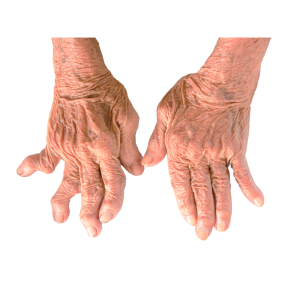Introduction
Almost always the onset of symptoms of rheumatoid arthritis (RA) is mostly very gradual, but sometimes it might start with an acute episode.
Likewise, it tends to affect the small joints in a diffuse manner (polyarthritis), as many joints of the hands. In addition the joints of the upper neck get arthritis simultaneously. By and large, in the beginning it affects only perhaps three or four of the “knuckles”of the hands.
The name of these joints are the metacarpophalangeal joints or “MCP joints” for short. There will be pain, swelling, heat, some redness of the overlying skin and loss of range of motion of the affected small joints. In addition, the joints have effusions (fluid build-up) and the synovial membranes get inflamed, a condition termed”synovitis”. In the long run this process leads to eventual scarring and joint stiffness.
Unfortunately it seems like the inflammatory process does not stop at the joint level at all, but it also involves the tendons that travel across the joints in the hands and the support ligaments. In brief, loss of these support structures leads to the grotesque deformities with ulnar deviation of the MCP joints. To summarize, tendons thicken and show nodules and can even rupture due to a softening up of the structure as a result of the inflammatory process (Ref. 1 and 2).
The RF titer (=rheumatoid factor titer)
_____________________________________________________________
In essence, there is a lack of understanding why the immune system in rheumatoid arthritis patients has undergone a change. But this seems to be the underlying pathophysiological process that is behind all of these symptoms. However, we do know that there are changes in the immune system of rheumatoid arthritis patients. This produces an abnormal antibody to altered immunoglobulins. The name for this abnormal antibody is rheumatoid factor (RF) or rheumatoid antibody. As long as it is low, the disease process is not yet systemic, but if it is high, the disease is more aggressive and systemic spread into all body joints is more likely. As a result both this blood test together with the erythrocyte sedimentation rate(=ESR) are a useful test to help diagnose and monitor the progress of the treatment of rheumatoid arthritis in affected patients.
Rheumatoid antibody directed at altered proteins in synovial membrane of joints
This antibody in RA aims at at altered proteins in the synovial membrane of joints, tendon sheaths and in a few more serious cases at other areas of the connective tissue including arterial walls. This distinguishes RA from other connective tissue diseases such as Sjögren’s syndrome where the autoantibody attacks the salivary and lacrimal glands resulting in a dry mouth and in dry eyes. There is ample evidence in the immunological literature that the key to understanding RA and other connective tissues diseases is the altered immune response (T helper cells, plasma cells, macrophages, autoantibodies etc.). This leads to joint, cartilage and tendon destruction.
_____________________________________________________________
Symptoms and signs of rheumatoid arthritis
The following summarizes various other symptoms and signs of RA (modified from Ref. 1 and 2):
In the spine the upper end of the cervical spine is often affected with subluxations of the joints between the first and second vertebral bodies(atlantoaxial subluxation).There is a danger of spinal stenosis and/or spinal cord compression.
Rheumatoid nodules
Rheumatoid nodules happen in about 20% of patients with RA. They are hardened fibrotic lumps in the skin at the outside (extensor surface) of the elbows (thanks to www.medscape.com for this image) where pressure occurs from leaning on them, as well as the Achilles tendons, where shoes exert pressure onto the skin.
Vascular Damage
Vascular Damage from immune complexes that are deposited in the vascular walls.
A variety of different clinical signs are associated with this: skin ulcers, occlusion of vessels going to fingers or toes with a threat of loss of these. The nutritional vessels of nerves can be affected and a painful neuritis of a nerve can develop. The minifiltration system of the kidneys can be damaged (glomerular vessel infarcts), which makes the kidneys much more prone to toxicity of drugs that are used to treat RA. In the final stage a rare condition, called amyloidosis can lead to even more kidney damage.
References
1. ABC of rheumatology, second edition, edited by Michael L. Snaith , M.D., BMJ Books, 1999. Chapter 10.
2. The Merck Manual, 7th edition, by M. H. Beers et al., Whitehouse Station, N.J., 1999. Chapter 50.
3. J O’Dell J Rheumatol Suppl 2001 Jun;62:21-26.
4. ET Koh Ann Acad Med Singapore 2001 Mar;30(2):170-173.
5. AJ Ostor et al. Aust Fam Physician 2001 Apr;30(4):314-320.
6. C Richard-Miceli et al. BioDrugs 2001;15(4):251-259.
7. B. Sears: “The age-free zone”.Regan Books, Harper Collins, 2000.
8. B. Sears: “Zone perfect meals in minutes”. Regan Books, Harper Collins, 1997.
9. Ferri: Ferri’s Clinical Advisor: Instant Diagnosis and Treatment, 2004 ed., Copyright © 2004 Mosby, Inc.
10. Rakel: Conn’s Current Therapy 2004, 56th ed., Copyright © 2004 Elsevier







